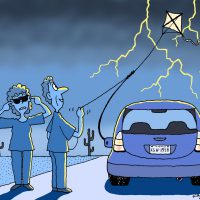
Welcome to another Tesla Tuesday! Let’s talk about range anxiety. It’s the most common topic when people hear that we’re buying an electric car. “What happens when you run out of battery?” When someone asks me that, I usually ask “When was the last time you ran out of gas?” And that can be followed up with “Would you have run out of gas if your car was magically filled up every morning when you woke up?”
Everything in the car is built to help ensure that you never run out of battery. If you set your destination, you’ll be automatically routed to chargers along the way if you’re even close to not making it. And if you ignore the warnings, the car will become increasingly annoying at reminding you that you’re making bad choices. Pretty much the only way you can run out of battery is to do it on purpose.
But ok, let’s assume that you are somehow out for a drive and you magically end up with no battery. Then what? The first step is to call Tesla Roadside Assistance. If it was a car issue, they’ll take care of you, and if it was your own mistake, they’ll still help you but you’ll end up paying the bill. The likely response is that your car will get put on a flatbed and towed to a charger. After a few minutes at the charger, the car can be unloaded and you’re on your way.
When our Escape had a dead battery in our garage, we had to get towed to the dealer and I realized that I didn’t know how to get it out of the garage onto the truck. It’s a keyless ignition system so how do I turn on the ignition to put it in neutral? I finally found a “brake shift interlock” that solved the problem. There’s a similar procedure for a Tesla. You need to charge up the 12v battery enough to power the screen so you can put it in tow mode. Then it can be pulled up onto the flatbed. There’s a procedure for getting into the frunk mechanically and getting to the 12v battery charge points.
EVs can generally be charged by generators too as long as they are a nicer generator that puts out a clean sine wave. You probably just need a few miles of charge to get to a real charger. As EVs become more common, there will be more roadside assistance vehicles driving around with this option.
So sure, it could theoretically happen. I could theoretically run out of gas too, but I don’t worry about that. If range anxiety was a real thing, I doubt that all four of Teslas cars would be in Consumer Reports’s list of the 10 most satisfying cars (and three of the top 4 spots are Teslas!) Want range anxiety to go away? Buy an EV.
